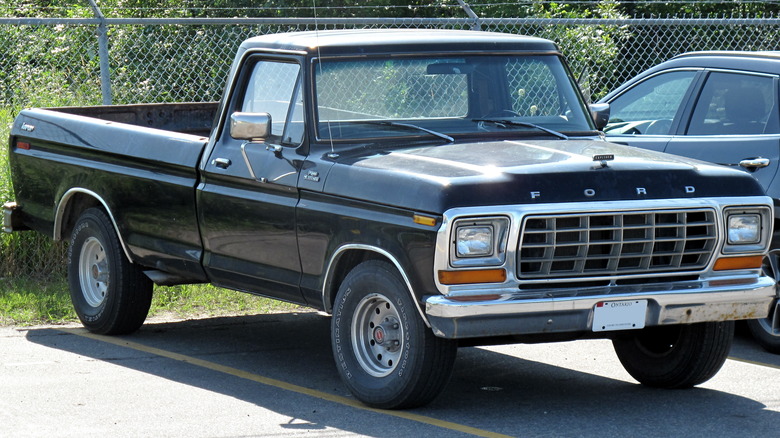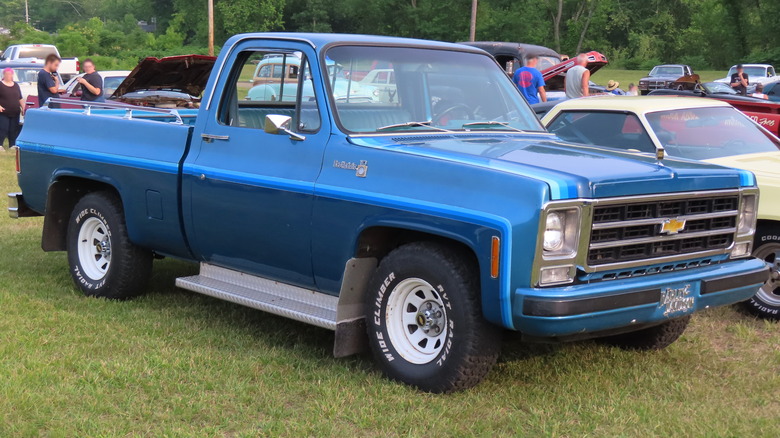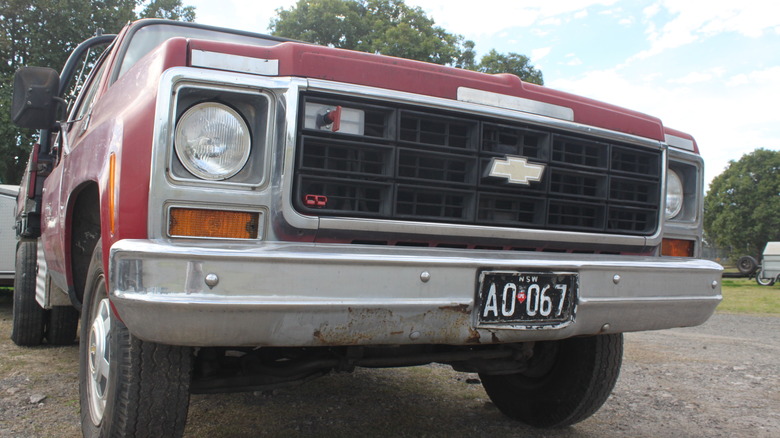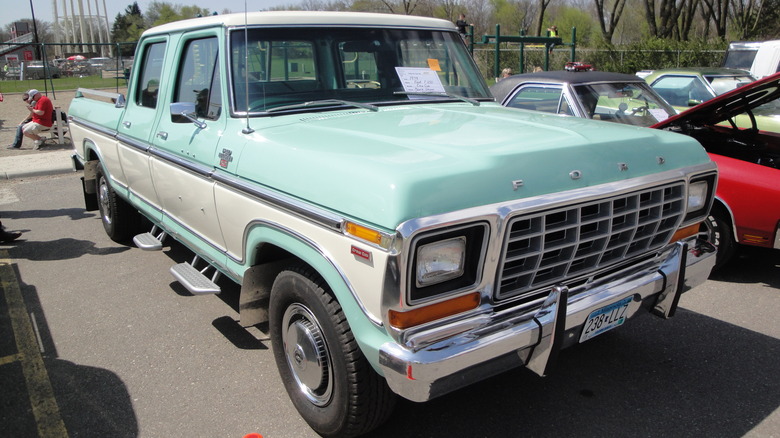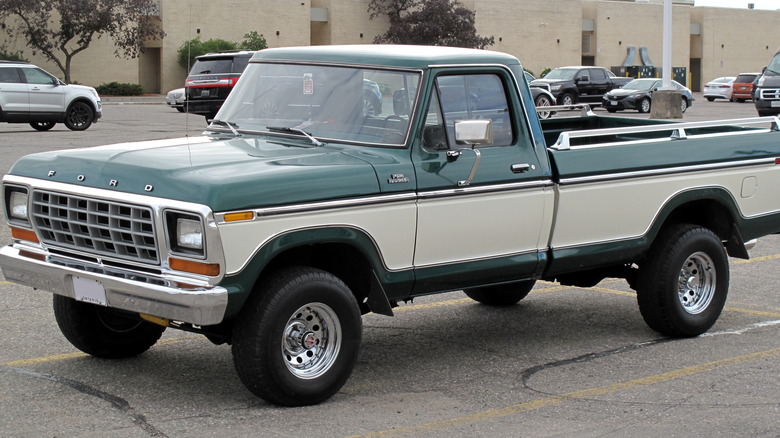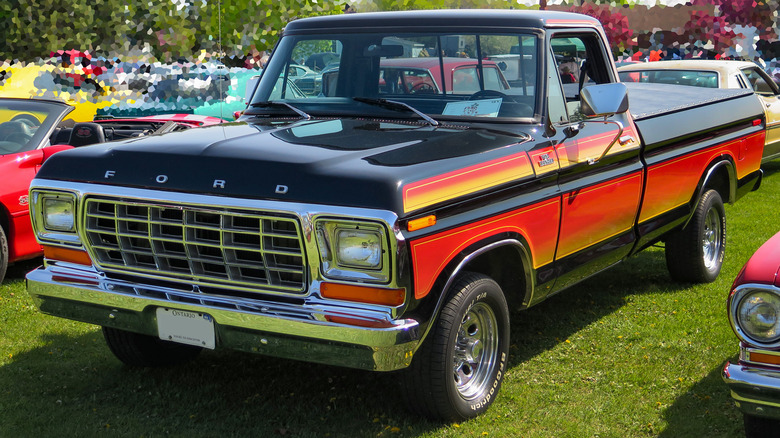The Biggest Differences Between 1979 Ford F-Series And Chevrolet C/K Classic Pickup Trucks
This past year, the Ford F-Series and the Chevrolet Silverado pickup trucks were the best-selling vehicles in the United States, which should come as no surprise. Ford trucks in particular have earned the number one position for many years now, and the Silverado usually follows right behind them at two or three in the rankings. In 2024 so far, they rank at the top of the list in sales, and as long as pickup trucks remain ever popular in the United States, their dominance shows no signs of slowing down.
Both pickup trucks have been around for many decades at this point. However, the Silverado was not always called the "Silverado," as the company adopted that name in 1999. Prior to that, Chevrolet's pickups were called the C/K series, a designation it shared with its sister company GMC — before it called these trucks GMC "Sierras."
You can go all the way back to the 1979 model year and find the Ford F-Series and Chevrolet C/K series competing with each other. The two had a number of similarities, but of course, each series of pickup truck had its own unique factors that differentiated the two from each other. Let's look at the 1979 models of these trucks and see how they compare.
[Featured image by Elise240SX via Wikimedia Commons | Cropped and scaled | CC BY-SA 4.0]
Sizes and designations
Back in 1979, Ford and Chevrolet both had different sized trucks that you could get in each's respective pickup series. For the Chevrolet C/K series, there were three different sizes available. You could get the C10 or K10, which were half-ton pickup trucks, the C20 or K20 (three-quarter ton), and, as you would expect, the one-ton C30 or K30.
For normal passenger pickups, the Ford F-Series technically had four different sizes available, but this was partly a technicality. The F-100 was Ford's signature half-ton pickup truck, but it also had the F-150, which was also a half-ton truck. The difference between the two is that the F-150 was created as a response to new 1970s emissions regulations, as Ford wanted to have a half-ton truck that didn't have to conform to these new standards. The F-100 could be classified as a light truck, whereas the F-150 was not, due to its gross vehicle weight being over 6,000 pounds. Along with those two, you had the three-quarter ton F-250, and one-ton F-350 available to purchase.
Beyond those, the F-Series had a lot more to offer when it came to large pickup trucks as well. There were the F-600, F-700, and F-800 available for those looking for trucks that needed to haul incredibly large payloads. The F-800 could max out with a gross vehicle weight of 32,000 pounds.
[Featured image by MercurySable99 via Wikimedia Commons | Cropped and scaled | CC BY-SA 4.0]
Two-wheel or four-wheel drive
Ford and Chevrolet both offered two and four-wheel drive versions of each pickup truck, but Chevrolet made this distinction far more apparent than Ford did. The reason behind Chevrolet using both C and K designations for its pickup trucks was for that exact purpose: Each letter represented how many wheels it drove with, as the C pickup trucks were rear-wheel drive vehicles, whereas the K ones were all-wheel drive. Therefore, a C10 and K10 were essentially the same pickup truck, but the difference came down to wheel operation.
Meanwhile, Ford also made four-wheel drive vehicles available, but you would hardly know that looking at things like the 1979 brochure for its pickup trucks. There is a cursory mention of the four-wheel drive option, but in the vast table of specs for someone to choose from to see which F-Series model they wanted, four-wheel drive is not an option. The only model that explicitly gets a 4x4 designation in the company's literature from the time is the F-600.
[Featured image by Jeremy via Wikimedia Commons | Cropped and scaled | CC BY 2.0]
Engine options
While you might think that the standard issue engine on the F-Series and C/K-series would be some kind of V6 or V8 engine, that was not the case. In fact, the standard engine on both was an inline-six engine, but were different sizes.
For the F-Series, Ford offered a 4.9L I6 as its baseline engine from the F-100 all the way up to the F-600. The engine would change depending on different options you wanted with your vehicle. For instance, if you wanted a SuperCab rather than the regular cab, the base engine was a 5.8L V8 instead. If you were to get a larger vehicle like the F-700 or F-800, you'd be getting a 6.1L V8 engine as standard. The standard engine for the Chevrolet was a slightly smaller 4.1L I6, and similarly, there was a variety of larger V8 engines for options — all the way up to a 7.4L V8.
Neither of these standard I6 engines were anyone's idea of great power. The Ford 4.9L I6 could only produce up to 117 horsepower, while the Chevrolet 4.1L V6 managed to reach 130 horsepower. The only engine from either company to get over 200 horsepower was the aforementioned optional Chevrolet 7.4L V8, but if torque was the number you were most interested, the lowest you were looking at was 210 pound-feet from the Chevrolet I6.
[Featured image by Greg Gjerdingen via Wikimedia Commons | Cropped and scaled | CC BY 2.0]
Fuel options
Almost every single pickup truck in the Ford F-Series and Chevrolet C/K-series were traditional gas-powered vehicles. No matter what size engine you had underneath the hood of your truck, you were most likely going to be filling it up with gas. There were two exceptions to this, as each company had a diesel-powered engine for one of the models of its trucks. However, the size of the trucks in which diesel fuel was an option was wildly different.
When it came to Chevrolet, the only diesel option available was a 5.7L V8 that you could put into a Chevrolet C10, specifically those that had either the Fleetside or Stepside trims. These were both sport packages for the half-ton pickup, with the difference being the Stepside having a short box. You may find it odd that diesel was only available in the smallest version of the C/K-series, but that's how it was.
Ford went to the complete opposite side of the spectrum for its diesel-powered vehicle. This fuel was only available for the F-7000. An additional "0" was how Ford differentiated the standard F-700 from the diesel version. This came with a V363 engine, which could generate up to 175 horsepower. That was quite a bit more than Chevrolet's diesel engine, which tapped out at 120 horsepower. Considering that the V363 was had nearly double the displacement at 10.4L, and was in a much larger vehicle, the disparity in horsepower makes sense.
[Featured image by Elise240SX via Wikimedia Commons | Cropped and scaled | CC BY-SA 4.0]
Aesthetic differences
Although the Ford F-Series and Chevrolet C/K-series do share a number of aesthetic similarities — from bench seating to often featuring a large stripe down the sides of the truck — each one has its own distinct look. However, these differences are rather subtle. For instance, the Ford branding would be written across the top of the pickup's front grille. Meanwhile, Chevrolet would put its emblem directly in the center of the grille.
Each company had a decent amount of options for how you wanted to customize your pickup truck. If you got a Ford F-Series truck, you had 17 different colors to choose from, while the Chevrolet pickups had 15 colors. On the other hand, Chevrolet gave you the option of having bucket seats with a center console instead of the standard bench seating, but Ford didn't have bucket seat options back in 1979 for these trucks. Both had the ability to install AM/FM radios, but the Ford is the only one that says stereo speakers are available.
When it comes right down to it, the Ford F-Series and Chevrolet C/K-series vehicles are quite similar. They have their variations, but just as they are today, we are still looking at half-ton, three-quarter ton, and one-ton American-made pickup trucks that remain some of the most popular vehicles in the United States — thanks to decades of consistency and success.
[Featured image by Elise240SX via Wikimedia Commons | Cropped and scaled | CC BY-SA 4.0]
